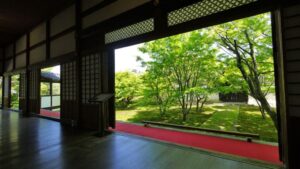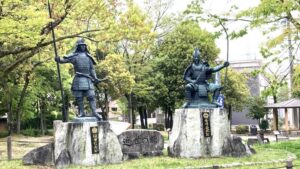The Battle of Nagashino and Shitaragahara
On May 21, 1575, the decisive battle at Nagashino and Shitaragahara began between Takeda Katsuyori’s forces (1546-1582, 武田勝頼), numbering 15,000 forces, and the 38,000-strong allied forces of Oda Nobunaga (1534-1582, 織田信長) and Tokugawa Ieyasu (1543-1616, 徳川家康). The Takeda forces charged towards the 2-km-long fence constructed by the allies. For nine relentless hours, the Takeda forces were subjected to continuous gunfire.
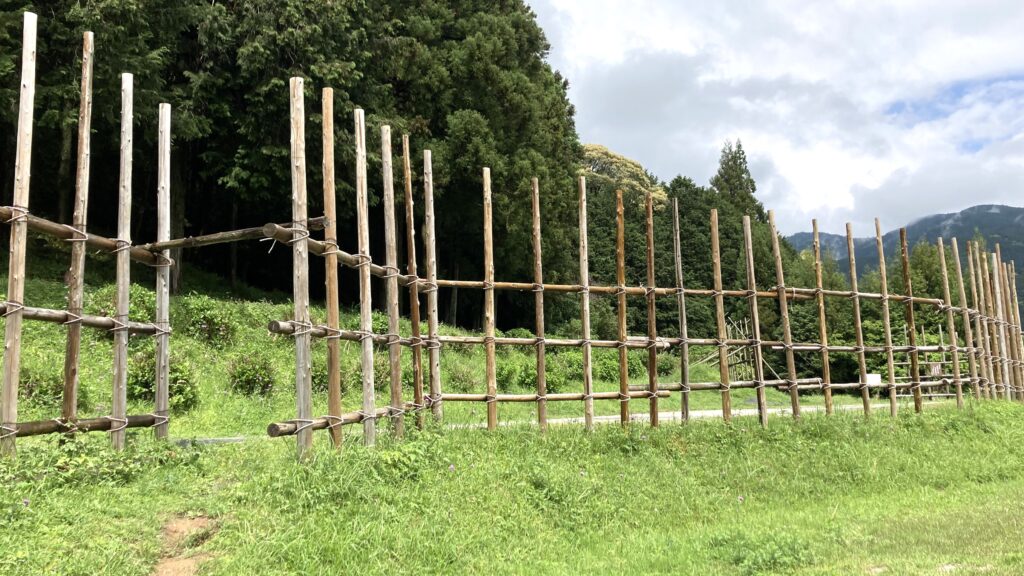
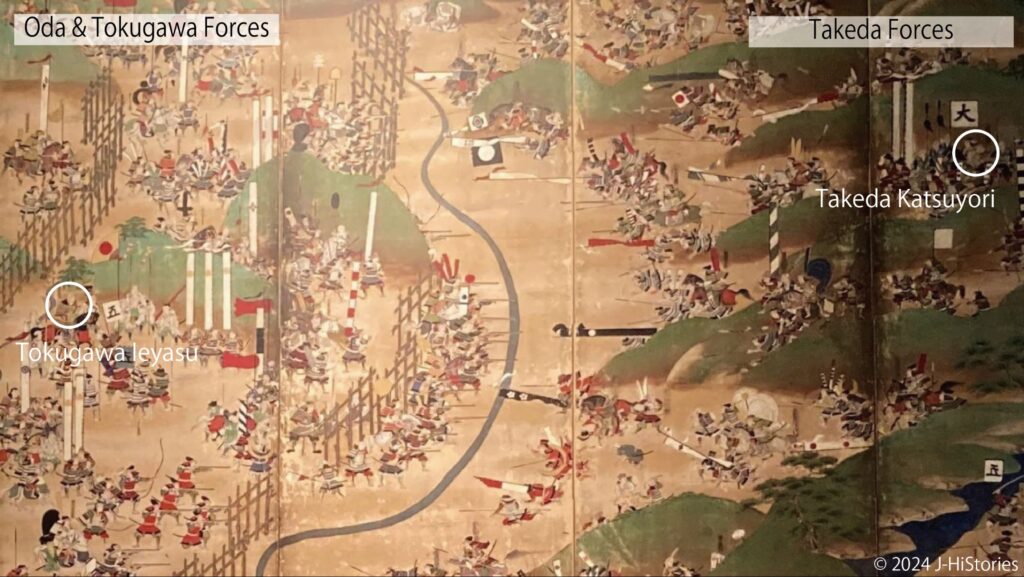
The Renowned Takeda Cavalry: Yamagata Masakage
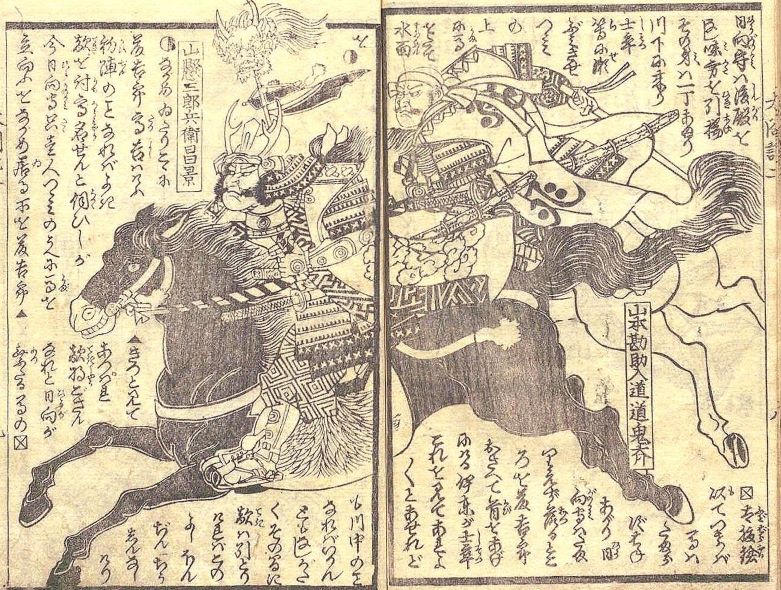
@ 芳虎 画『繪本太閤記』NDL
The renowned Takeda cavalry led by Yamagata Masakage, one of the Four Great Retainers of the Takeda clan, wearing the red armor and helmets, made a bold assault against the Allied forces who shot fire. In one notable episode,
Yamagata, along with Kosuge, Hirose, and Mishina warriors, fiercely fought against the Allied forces. However, once both Mishina and Kosuga were wounded and forced to retreat, Yamagata was shot and died in front of the fence.
Koyo Gunkan
Hearing Yamagata’s death, the Takeda forces withdrew, and the Oda and Tokugawa forces secured victory.
Prelude to the Battle
In 1573, two years before the battle, the powerful warlord Takeda Shingen (1521-1573, 武田信玄), known as the “Tiger of Kai,” died, leading a conflict between Ieyasu who aimed to recover authority in Mikawa territory, and Shingen's heir, Katsuyori. Ieyasu successfully retook Nagashino Castle, a critical stronghold in Takeda's Mikawa campaign, while Katsuyori seized Akechi and Takatenjin Castles in response. Katsuyori then sought to recapture Nagashino Castle. On May 1, 1573, Okudaira Sadamasa, the lord of Nagashino Castle, faced a siege by 15,000 Takeda soldiers. Despite fierce resistance, the Takeda attack gradually drove them back and the castle was about to fall. In this war situation, Ieyasu sought help from Nobunaga, whose forces arrived at Shitraragahara on May 18 and a standoff began.
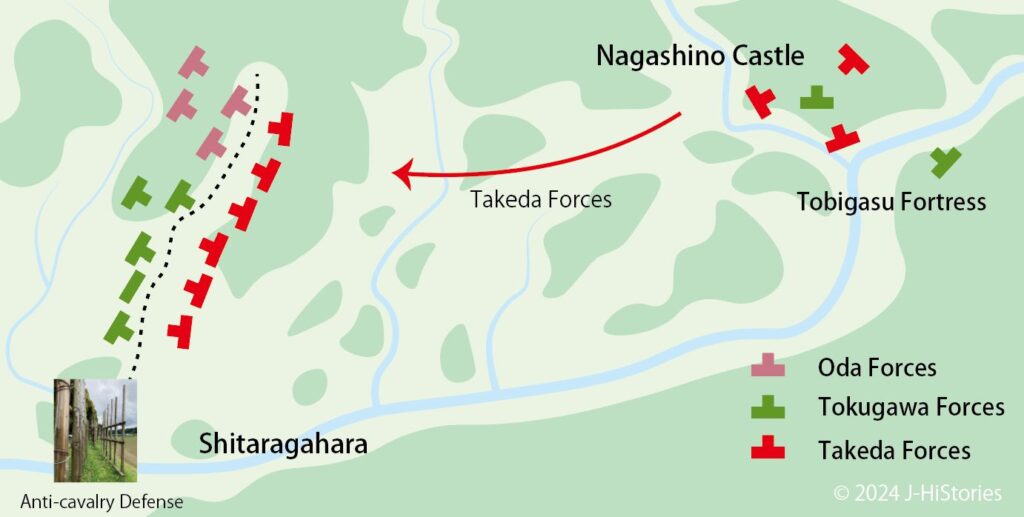
On May 21, the tide turned when Sakai Tadatsugu, Ieyasu's chief vassal known for his strategic eye and intimate knowledge of Nagashino Castle’s terrain, attacked Tobigasu Fortress overlooking Nagashino Castle from the rear, placing the Takeda forces in a dangerous position. In a situation where you could be attacked from behind, the Takeda forces had no choice but to charge toward the Oda and Tokugawa armies, where around 3,000 guns awaited. It proved to be the moment when fortune favored Oda and Tokugawa. Unified, Oda and Tokugawa forces attacked the Takeda's brave and strong cavalry with relentless gunfire. Tokugawa's gunmen fought hard in front of the horse-proof fence.
Furthermore, Tokugawa’s vassal, Naruse Masakazu, identified the banner of Takeda's generals and directed the gunmen to take shots at them. Later, Masakazu's heir became the lord of Inuyama Castle of Tokugawa Owari domain.
Shift from Cavalry Warfare to Modern Warfare
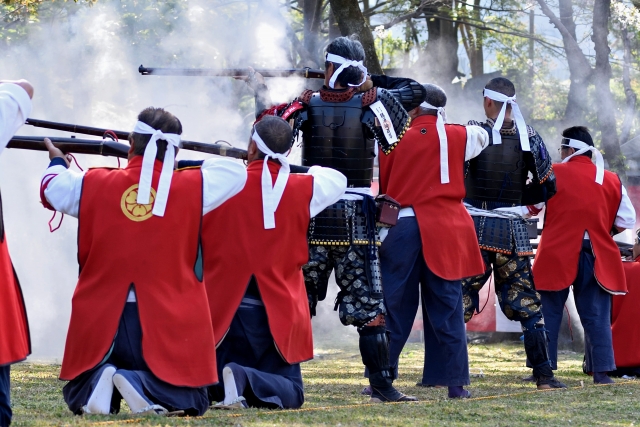
The allied forces fired their guns continuously for approximately nine hours, bombarding the Takeda forces with a seemingly inexhaustible supply of ammunition, sending shockwaves across Japan. Nobunaga imported significant quantities of firearms and raw materials, including niter and lead, through his control of the trading ports of Nagasaki, Osaka, and Sakai, ensuring an inexhaustible supply of ammunition. Indeed, the ability to sustain a 9-hour relentless barrage without depleting ammunition played a vital role in his victory.
Recognizing the critical importance of firearms, Katsuyori had also prepared many guns. However, the Takeda clan struggled to secure sufficient gunpowder. For instance, the Takeda ordered a shrine to "select good quality copper coins from the saisen (money offered to the deity) and pay them to the Takeda. In return, you will be compensated with gold." A chemical analysis of bullets excavated from the Nagashino Castle ruins revealed that their composition matched that of coins imported from China.
Three Great Warlords: Nobunaga, Ieyasu, and Katsuyori
Later, Oda Nobunaga nearly unified Japan but was assassinated in the Honnoji Incident. Tokugawa Ieyasu, on the other hand, established a peaceful era that lasted for 260 years. Takeda Katsuyori, despite briefly recovering his power, ended in 1582. Okudaira Sadamasa, rewarded for his defense of Nagashino Castle, took the name Nobunaga after receiving a character from Nobunaga’s name and constructed the new Shinshiro Castle.
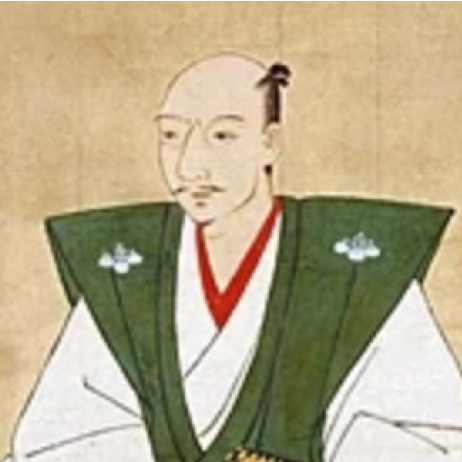
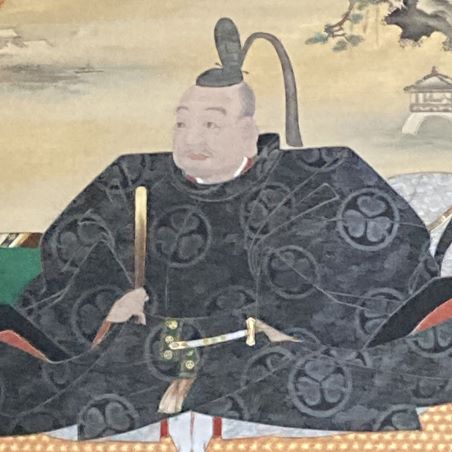
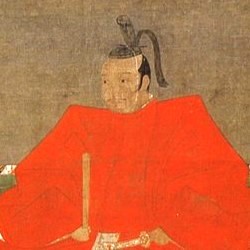
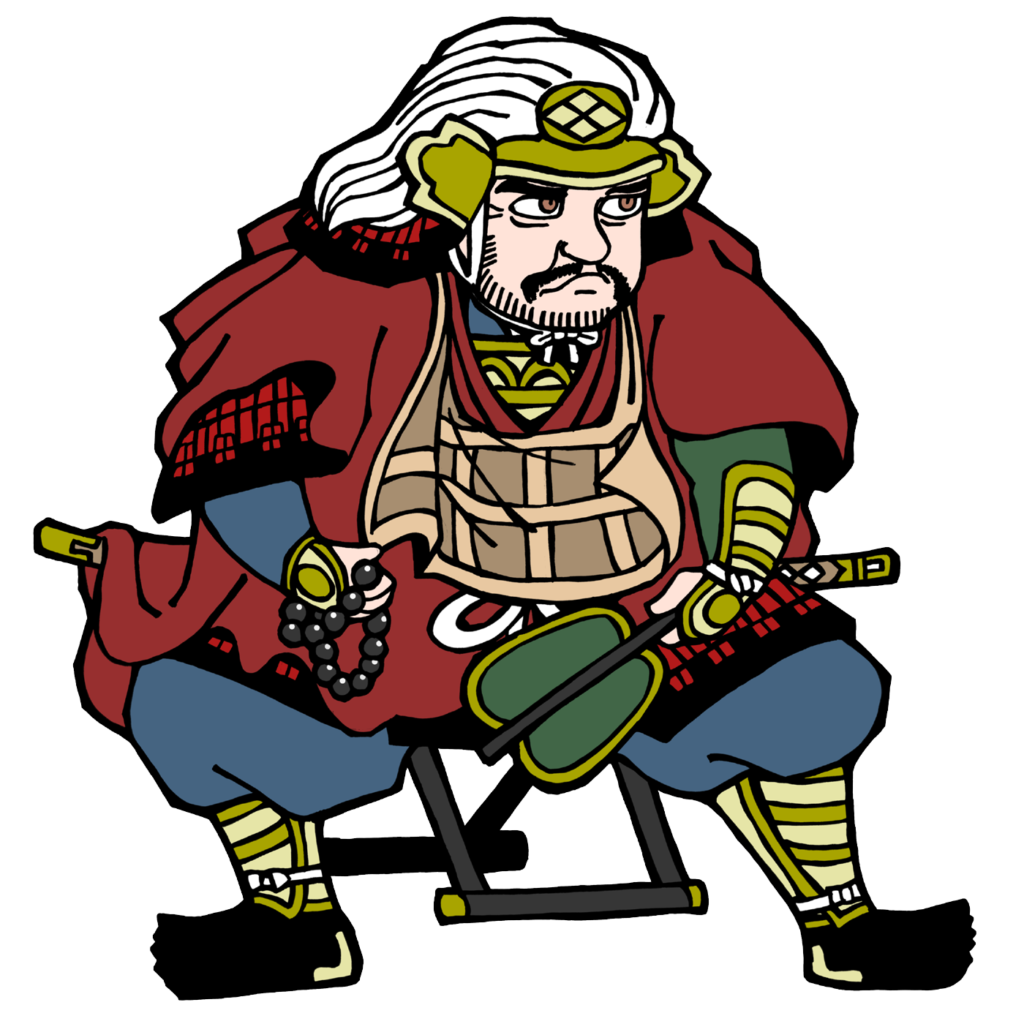
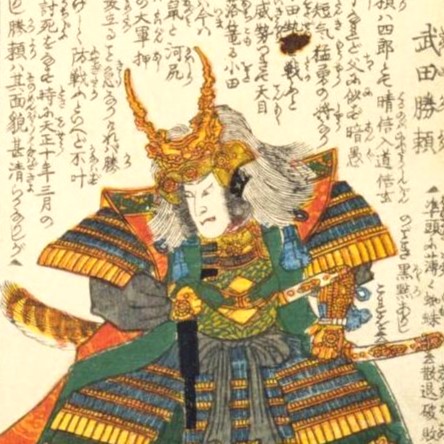
The Battle of Nagashino Timeline
| Oda Nobunaga | Tokugawa Ieyasu | Takeda Shingen and Katsuyori | |
| 1564/ | Captured Nagashino Castle from Takeda | ||
| 1571/ | Became hostile to the Takeda clan | Became hostile to the Tokugawa clan | |
| 1572/ | Captured Nagashino Castle from Tokugawa | ||
| 1572/12 | Was defeated by Shingen at Mikatagahara | Defeated Tokugawa forces at Mikatagahara | |
| 1573/ | Shingen passed away | ||
| 1573/12 | Re-captured Nagashino Castle from Takeda | ||
| 1575 | Asigned Okudaira as Nagashino Castle Lord | ||
| 1575/5/1 | Katsuyori surrounded Nagashino Castle | ||
| 1575/5/10 | Ieyasu asked Nobunaga for reinforcements | ||
| 1575/5/11 | Katsuyoshi attacked Nagashino Castle | ||
| 1575/5/15 | Okudaira's vassal escaped Nagashino Castle Requesed reinforcements to Ieyasu | ||
| 1575/5/18 | Nobunaga arrived at Shitaragahara | Katsuyoshi attacked Nagashino Castle | |
| 1575/5/21 | Sakai Tadatsugu attached TobigasuFortress | ||
| 1575/5/21 | The Battle of Shitaragahara started early morning | ||
| 1575/5/21 | Takeda forces escaped Shitaragahara | ||
| 1575/5/25 | Returned to his Gifu Castle | ||
| 1576 | Okudaira built Shinshiro Castle | ||
| 1579 | Azuchi Castle Keep was completed | ||
| 1581/3 | Re-Captured Takatenjin Castle from Katsuyori | ||
| 1582/3 | Katsuyori died. Takeda clan ended | ||
| 1582/6 | Honnoji Incident, Nobunaga died | ||
| 1603 | Ieyasu established Tokugawa Shogunate | ||
Recommendations to Visit
Nagashino Castle Ruin
Access: 1 hour from Nagoya Station to Toyohashi Station on JR Tokaido Main Line. Change the train. 1 hour to Nagashino Castle Station (長篠城駅) on JR Iida Line. A 10-minute walk.
Shitaragahara Historical Museum
Access: 1 hour from Nagoya Station to Toyohashi Station on JR Tokaido Main Line. Change the train. 50 minutes to Mikawa Togo Station on the Iida Line. Get off at Mikawa Togo Station (三河東郷駅). A 15-minute walk.

